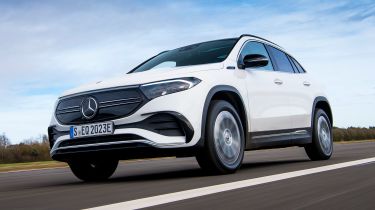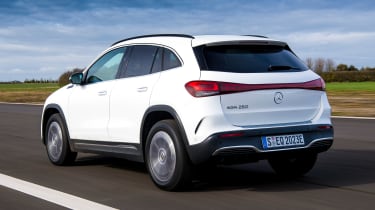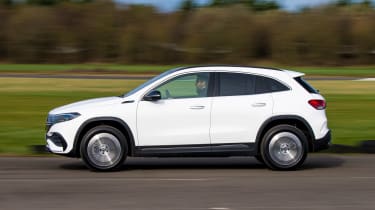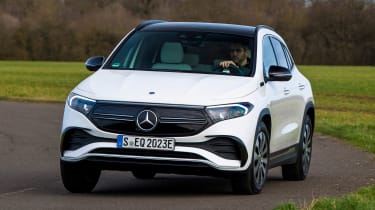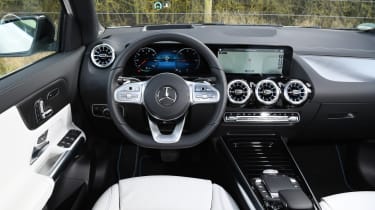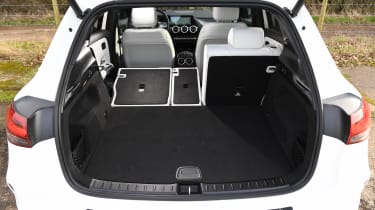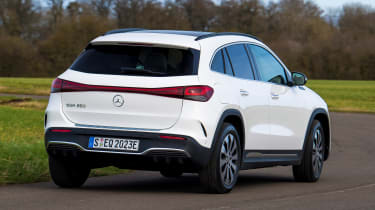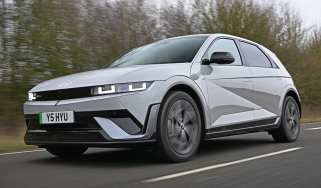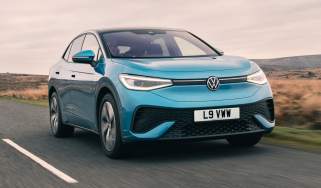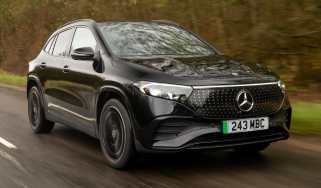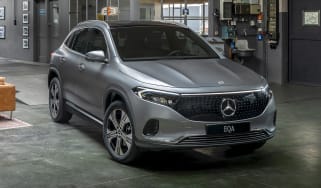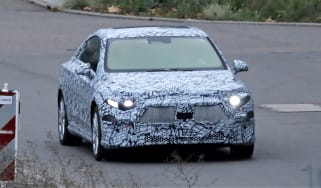Mercedes EQA SUV review
"The Mercedes EQA is the brand’s baby electric SUV and one that’s destined to struggle against purpose-built rivals”
Pros
- Classy interior
- Smooth and refined
- Impressive tech
Cons
- Small boot
- Not very quick
- Rivals offer faster charging
The Mercedes EQA is the brand’s smallest, most affordable all-electric SUV, sitting beneath the expensive Mercedes EQC. It arrives into a rapidly growing class, with heavily-hyped EV rivals like the Volvo XC40 P8, Volkswagen ID.4, Tesla Model Y and Ford Mustang Mach-E vying for buyers' attention.
Like the Volvo, the EQA is based on an existing model and has been comprehensively redesigned for electric power. This is evident from its design, with clear similarities to the Mercedes GLA donor car and the lack of a 'frunk' storage area under the bonnet. Mercedes has tried to give the EQA a distinct personality, with a new nose based on that of the EQC, a striking full-width rear light bar and the relocation of the rear number plate onto the bumper.
Even in the entry-level EQA 250, Mercedes has squeezed in a 66.5kWh battery and a 187bhp electric motor, sending power to the front wheels via a single-speed automatic transmission. Range is up to 263 miles in ideal conditions, and we found it predicted a range of around 200 miles on the cold, wintry day when we tested it. Acceleration is smooth and linear, giving similar performance to a turbodiesel but with a more instant response. The handling is steady and secure but the light steering and some body lean mean it isn't the enthusiastic driver's choice.
lf more performance is required, the EQA 300 and EQA 350 get 225bhp and 288bhp respectively and also feature 4MATIC four-wheel drive. This is thanks to a dual-motor setup, instead of the single motor of the EQA 250. Surprisingly, driving range is unaffected, with all versions capable of up to 264 miles on a single charge, despite the power differences.
The interior is very similar to the GLA's, so there’s a handsome design, sporty chrome-ringed air vents and a modern widescreen infotainment display. Even the entry-level Sport version is well equipped, which is a good thing, as adding the Premium Plus pack to AMG Line sees the EQA's price rocket to over £50,000, at which point the EQA begins to look rather less sensible.
 Top 10 best electric SUVs – the ones to buy in 2025
Top 10 best electric SUVs – the ones to buy in 2025
Costing from around £44,000 and with low Benefit-in-Kind, VED (tax) exemption and cheap top-ups all working in its favour, the EQA looks like a good deal, even if it's too expensive to qualify for the latest version of the Plug-in Car Grant (PiCG). It's not even much more expensive than a petrol or diesel Mercedes GLA. There are some compromises, though, because the reliance on an existing platform means purpose-built electric cars like the ID.4, Model Y and Mach-E boast advantages in some key areas like interior packaging.
MPG, running costs & CO2
Electric models have long been the expensive option because of their expensive batteries and technology. The EQA is something of a breakthrough because its price is comparable with a well-specced petrol or diesel Mercedes GLA. It's a shame, however, that it's no longer eligible for the PiCG, sitting above the government's lower, £35,000 threshold.
The car’s 66.5kWh battery serves up a reasonable, if not outstanding, range of up to 264 miles between top ups. This falls between the Volvo XC40 P8 and Volkswagen ID.4, and on a winter's day we saw over 200 miles from a full charge. Like all EVs, the EQA benefits from annual VED (tax) exemption and will be very attractive to company-car drivers, thanks to its 1% Benefit-in-Kind tax - compared with 11% for the GLA 250 e plug-in hybrid and more like 32% for a diesel GLA.
Like its range, the EQA's charging capabilities are also competitive without being jaw-dropping. It can be topped up at a maximum rate of 100kW (the XC40 P8 manages up to 150kW), with a 10-80% charge taking 30 minutes. Charging from 10-100% using a home wallbox takes less than six hours.
Engines, drive & performance
We've already mentioned that the EQA is based on conventional underpinnings from the GLA, and this also means it isn't a dual-motor powerhouse that's out to set acceleration records. If that's what you're after, the Tesla Model Y or Ford Mustang Mach-E will be more suitable. Instead, the EQA 250 has a single 187bhp electric motor under the bonnet that makes it feel brisk but not truly rapid. It still has the instant response that gives electric motors a real advantage over combustion engines but from a standing start, Mercedes seems to have tuned the GLA to be as smooth and progressive as possible. Acceleration from 0-62mph takes 8.9 seconds, while its top speed is 99mph.
As it’s smaller and lighter than the Mercedes EQC, the EQA feels more nimble, but it's also as secure and predictable as you'd expect for an SUV with a three-pointed star on the front. That's about as good as it gets though; light steering and body lean through corners means the stiffer Polestar 2 is more fun and engaging along a British B-road.
For an added dose of performance, there's also the EQA 300 4MATIC and EQA 350 4MATIC, both of which feature a dual-motor powertrain with four-wheel drive for extra traction in slippery conditions. Power also increases to 225bhp and 288bhp respectively, cutting the 0-62mph dash to 7.7 and 6.0 seconds. Top speed remains unchanged, as both are limited to 99mph.
Interior & comfort
The EQC impressed with its refinement, and the smaller EQA is also hushed around town, with just a gentle background hum of tyre and wind noise on the motorway. Adaptive dampers didn't appear to have much effect on the suspension, however, with ride comfort fairly similar even if you hop between Comfort and Sport modes.
Quality is mostly excellent, thanks to lots of soft-touch materials and the same excellent widescreen infotainment system and trackpad you'll find in more expensive Mercedes models. Cheaper plastics can be found but only lower in the footwells and boot. Attractive circular air vents, sporty steering wheels and plush seats also help reinforce the EQA as an upmarket small SUV.
Just like the GLA, trims span from Sport to AMG Line, with the option of Premium and Premium Plus versions to add even more luxury. It's worth noting, however, that it's easy to take the EQA to over £50,000, at which point it doesn't look such good value for money. Standard EQA's are hardly spartan, with 18-inch alloy wheels, LED lights, sat-nav, Artico man-made leather upholstery, Apple CarPlay and Android Auto.
AMG line gives the EQA a more sporting exterior and interior design, with additions like sports seats and aluminium trim. The Premium pack brings 19-inch wheels, a panoramic sunroof and keyless go. Premium Plus ups the wheel size again to 20-inches, controlled by adaptive dampers, along with a 360-degree camera view, head-up display and Burmester stereo.
Practicality & boot space
One of the reasons so many in the first wave of EVs have been SUVs and crossovers is because their extra height makes it easier to add a large battery under the floor without spoiling their design or packaging. However, this can only work up to a point when adapting an existing combustion-engined car to electric, and one trade-off in the EQA's case is the small 340-litre boot, which is smaller than that of a Renault Clio.
The EQA's height does mean the front and rear seats are fairly spacious, with enough room for adults to travel in comfort, but it's a shame the floor for rear seat occupants isn't completely flat, like in some rivals. If you own a caravan or horsebox, the EQA won't be up to the task unfortunately, because its towing limit for both unbraked and braked trailers is set at 750kg. A GLA 250 petrol can tow up to 2,000kg, so this is one area where the conventional model is a long way ahead.
Reliability & safety
Mercedes hasn't had the best reputation for reliability in recent years but there are some green shoots appearing. For instance, the Mercedes A-Class hatch - which both the GLA and EQA are based on - came 36th out of the top 75 models in our 2020 Driver Power owner satisfaction survey. Out of those who responded, a reasonably small 12.8% told us their A-Class had a fault within the first year. Hopefully the EQA can build on these solid foundations and be even more reliable thanks to the simplicity of its electric setup.
Every EQA is fitted with a healthy roster of safety kit, and it's good to know its A-Class sibling already received a five-star score in Euro NCAP safety tests. Standard equipment includes active lane keeping assist, blind spot warnings, autonomous emergency braking and active speed limit assist. There's also an emergency call system designed to contact the emergency services if the car's sensors detect a severe collision.
Which Is Best?
Cheapest
- NameEQA 250+ 140kW Sport Executive 70.5kWh 5dr Auto
- Gearbox typeAuto
- RRP£50,340
Most Economical
- NameEQA 250+ 140kW Urban Edition 70.5kWh 5dr Auto
- Gearbox typeAuto
- RRP£52,600
Fastest
- NameEQA 300 4M 168kW AMG Line Executive 70.5kWh 5dr At
- Gearbox typeAuto
- RRP£53,600

